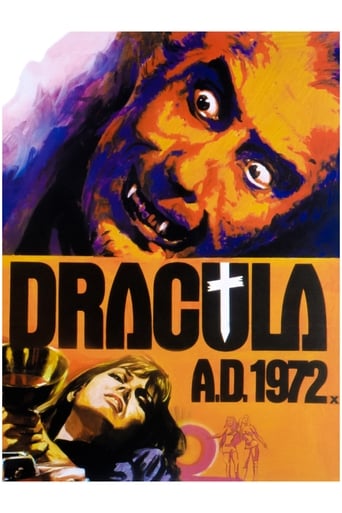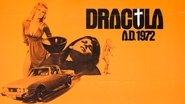JLRVancouver
Despite the presence of Hammer's iconic Gothic duo of Peter Cushing and Christopher Lee, "Dracula AD 1972" is a pretty mundane entry into the Dracula canon. Briefly, a group of counter-culture types get tricked into an unholy attempt to resurrect the blood-sucking count by "Johnny Alucard" (Christopher Neame) with predictable results. One of participants at the dark ceremony is the granddaughter of Professor Lorrimer Van Helsing (Cushing), who is in turn the grandson of Lawrence Van Helsing, who had dispatched the vampire exactly 100 years earlier and a vengeful Dracula (Lee) is out for blood, figuratively and literally. Cushing and Lee are fine playing their standard tropes but the youths are an uninteresting bunch and I doubt if anyone will much care if they live or die or undie. The worst part of the film is the soundtrack. I can accept that, when the music is actually embedded in the story (such as in the bar), then the music needs to match the scene but most of the score is simply background and setting Dracula and van Helsing's climatic showdown to cheesy '70's cop-show music quickly kills any sense of drama or horror. There are a number of ridiculous scenes such as Van Helsing working out the mystical significance of 'Aulcard's name as though he was deciphering the Rosetta stone, gory scenes with blood that sometimes looks like catsup, other times like vermillion poster paint, and above all Christopher Neame's hammy summoning of the Prince of Evil (admittedly a good 'who's who' of evil). Presumably, the film was an attempt of Hammer to ingratiate itself into a new generation of viewers and the film opens with the groovy, free-loving, hippie-types crashing a party hosted by a bunch of snooty 'upper class' types who are mocked for their 'squareness' until the 'fuzz' show up (a scene that serves no real purpose other than establish the 'hipness' of the film). The scenes featuring Cushing and Lee are too brief and the rest of the movie is not really worth watching, so this one's a miss for all but core vampire fans.
Roman James Hoffman
In the late 1950s Hammer Films revolutionised horror with the likes of 'The Curse of Frankenstein' (1957) and 'Dracula' (1958) which, for the time, pushed boundaries in terms of gore (not least through the knowledgeable use of colour film) and eroticism. They were commercial and critical successes that resurrected a dead genre (pun intended) and opened the door for a boom in horror movies equivalent to that in the 1930s.However, cut to the beginning of the 1970s and society itself had gone from Black and White to Technicolour due to the flowering of the counter-culture which saw all social institutions subject to intense criticism or outright attack and in horror we had seen the all-out assault of George A. Romero's 'Night of the Living Dead' (1968). As a result, recognising that quaint Vampire movies from England just don't get the scares they used to, Hammer tried to change things up. One thing they tried was ditching the subtle but potent eroticism for simply showing more tits and having the women engage in lesbianism. Another, more respectable, thing was to attempt to update the vampire story to make it more relevant to a modern audience. And from this comes 'Dracula AD 1972'.The plot is basically the same as any other of the Dracula sequels that came in the wake of 'Dracula' (1958): the count, dead since his last encounter with Van Helsing is brought back by a dutiful underling and seeks revenge. The film begins with an impressive period piece prologue showing Dracula's staking a hundred years ago and then, panning up, a plane screeches across the sky announcing the updated setting. The film then cuts to an amusing scene where a group of young hip cats (led by the charismatic and aloof Johnny Alucard) have gate-crashed a party and are "terrorising" the owners in the most limp and middle-class way. Later on they talk of where the next far out thrill will come from when Johnny suggests a black mass. They all attend for kicks but get freaked out when Johnny seems to take it too seriously and wants Jessica (family name Van Helsing) played by Stephanie Beacham, to get involved. She declines but the Prince of Darkness is summoned with the aid of another girl and, awakened to the twentieth century, Dracula is out for revenge.The film has been criticised by many as a failed attempt to desperately breathe life into the franchise, and while that charge can't be escaped, the conceit of the film to update Dracula is not a bad one. If anything, the failing of the film is that it didn't go far enough in its updating and still feels like the reserved period pieces which came before just in funky threads and platforms. What's more, director Alan Gibson (who would direct the next attempt to update Dracula with the much worse 'The Satanic Rites of Dracula') is no Terence Fisher and lacks the directorial subtleties which distinguish the earlier features. Still, Peter Cushing and Christopher Lee are sheer class, as always, and raise the film up a notch or two.All told, it's a decent attempt, with some good moments, and manages to be fun ride. However, considering that 'The Exorcist' was around the corner, it's no surprise poor old Dracula couldn't cut it. Which is sad.
Wuchak
England's Hammer Studios did 9 Dracula or vampire films from 1958-1974:1. Horror of Dracula (1958); 2. Brides of Dracula (1960); 3. Dracula, Prince of Darkness (1966); 4. Dracula has Risen from the Grave (1968); 5. Taste the Blood of Dracula (1970); 6. Scars of Dracula (1970); 7. Dracula A.D. 1972 (1972); 8. The Satanic Rites of Dracula (1973); and 9. The Legend of the 7 Golden Vampires (1974).Christopher Lee plays the Count in all but "The Brides of Dracula" and "The Legend 7 Golden Vampires." Peter Cushing also stars in four entries as Van Helsing.By the time of the seventh film the creative well was apparently running dry and Hammer decided to spice up the series by bringing the Count to present-day London (1972, of course), which was Hammer's response to other successful vampire films at the time taking place in the modern day, such as "The Night Stalker," "Blacula" and "Count Yorga." The story revolves around a group of hip counter-culture youths performing a black mass in an abandoned church for kicks (although the ringleader takes it serious) and they revive the blood-sucking prince of darkness. Havok ensues.Peter Cushing appears as Van Helsing's descendant. Christopher Neame plays the nutjob who performs the black mass with utter relish. Also on hand are the stunning beauties Stephanie Beacham and Caroline Munro. Stephanie plays Van Helsing's daughter and Caroline has a small but significant role. There are a couple of other early-70s hippie babes as well.The first half of the film borrows heavily from the previous "Taste the Blood of Dracula" in that the Count is resurrected in roughly the same manner, although "Taste" is more effective. Which isn't to say that "Dracula A.D. 1972" isn't a decent entry in the series, albeit bizarre. The main problem with the film is that the story doesn't seem to know what to do once Dracula is resurrected. For instance, Cushing's final battle with the Count is fairly lame for various reasons (I don't want to give anything away), not to mention Lee only appears for about 10 minute in the entire film, which is usual for the series, of course.Another problem is the score. It screams "early 70s" in a bad way, but doesn't mesh with what is essentially a serious horror flick. Of course some would cite that as part of its charm. I said "serious horror flick, by the way, because this is not a goofy or campy flick despite the colorful hippie elements and lousy score.What works best is that it's a great period piece. You'll get a groovy glimpse of England's counter-culture, including the hippie girls and a live performance by the band Stoneground (who didn't go anywhere beyond this movie, likely because their sound & style was already passe by 1972). So, the first half is fun and compelling, whereas the second half just sort of goes through the motions and peters out.BOTTOM LINE: "Dracula A.D. 1972" is hard to rate because, despite the mediocre-ness of the story's second half, the film is a fun experience with numerous highlights. Hence, as a Dracula story I give it a C+, but for entertainment value I give it a solid B or B+.The film runs 96 minutes and was shot in England.GRADE: B-
AaronCapenBanner
Alan Gibson directed this attempt to update the Dracula legend to the "modern" times tells a new story that begins in 1872, where professor Van Helsing(played by Peter Cushing) battles Dracula(played by Christopher Lee) atop a runaway carriage to their mutual deaths. 100 years later, a descendant of a Dracula disciple uses black magic to resurrect him, where he promptly goes on a killing spree, and only the descendant of Van Helsing(Peter Cushing) can stop him. Failed film is a total disaster, with an illogical and preposterous plot, and horridly dated style. A real wasted opportunity by not linking this with the first five films in the series; why bother with a new back story?






